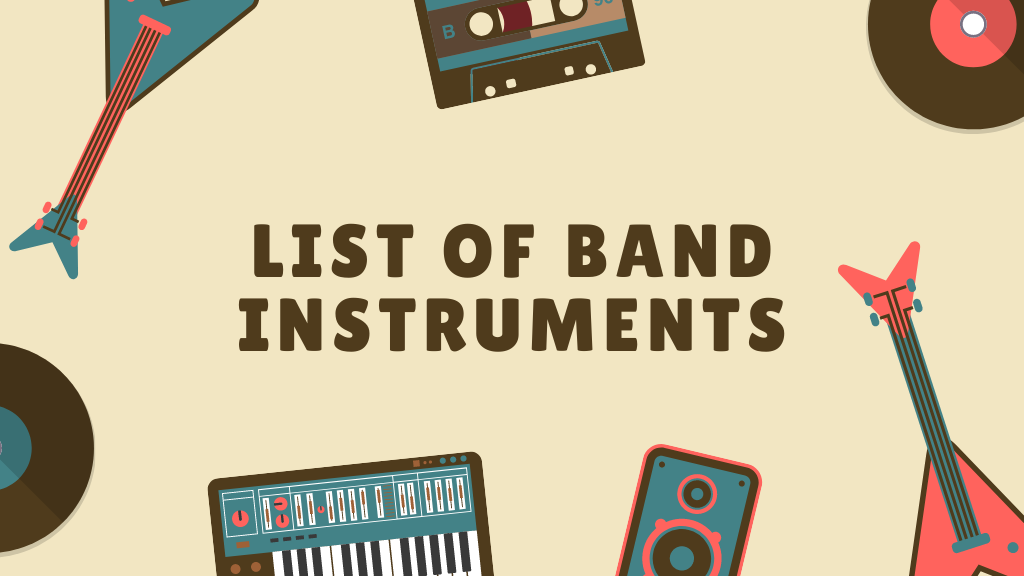Imagine the rhythmic beats of drums, the melodious tunes of a saxophone, or the bold sounds of a trumpet. Band instruments form the backbone of many musical ensembles, infusing life and energy into performances. In this article, we’ll explore the list of band instruments.
List of Band Instruments
Here is the list of Band Instruments:
- Brass Instruments
- Trumpet
- Trombone
- French Horn
- Tuba
- Euphonium
- Woodwind Instruments
- Flute
- Clarinet
- Saxophone
- Oboe
- Bassoon
- Percussion Instruments
- Snare Drum
- Bass Drum
- Cymbals
- Timpani
- Xylophone
- String Instruments in Bands
- Violin
- Viola
- Cello
- Double Bass
- Harp
- Less Common Band Instruments
- Piccolo
- English Horn
- Bass Clarinet
- Baritone Saxophone
- Contrabassoon
Let’s delve into these categories and discover the instruments that fall under each.
Brass Instruments
The brass section is known for its powerful and resonant sound. These instruments are played by buzzing lips against a mouthpiece and manipulating valves or slides.
- Trumpet: The trumpet is celebrated for its bright, clear sound and versatility. Common in both jazz and classical music, it often carries the melody, showcasing its dynamic range and expressive capabilities.
- Trombone: The trombone is unique among brass instruments due to its use of a slide to change notes. This feature allows for a distinctively expressive and fluid sound, making it a favourite in various musical genres.
- French Horn: Known for its warm and mellow tone, the French Horn is a regular fixture in orchestras and bands. It plays both harmonic and melodic roles, often adding a rich, romantic quality to the music.
- Tuba: As the largest brass instrument, the tuba provides the bass foundation in bands. Its deep, resonant tones are essential in creating a full, rounded sound in ensembles.
- Euphonium: Similar to a small tuba but with a more agile and lyrical quality, the euphonium is known for its rich, mellow sound. It often plays a supportive melodic role, adding depth to the brass section.
Woodwind Instruments
Woodwinds produce sound through the vibration of a reed or by blowing across a mouthpiece. They are key in adding color and texture to music.
- Flute: The flute is played by blowing across the mouthpiece, producing a light, airy sound. Its ethereal tone is often used for melodic and decorative lines in music.
- Clarinet: Offering a wide range of notes, the clarinet is known for its flexible and warm tone. It’s versatile, able to perform intricate solos as well as blend harmoniously in ensembles.
- Saxophone: A staple in jazz music, the saxophone is celebrated for its distinctive, vibrant sound. It brings a unique color to music, capable of both powerful solos and rich supporting roles.
- Oboe: Known for its clear and penetrating voice, the oboe often takes on solo lines in orchestral and band settings. Its distinctive tone adds a poignant, lyrical quality to music.
- Bassoon: The bassoon, with its deep, reedy sound, adds depth and richness to the woodwind section. It provides a lower register that balances the brighter tones of the other woodwinds.
Percussion Instruments
Percussion instruments are all about rhythm and timing. They can be melodic or purely rhythmic.
- Snare Drum: The snare drum stands out for its sharp, crisp sound. It’s a key element in rhythm sections, vital for maintaining tempo and adding a dynamic quality to the music.
- Bass Drum: The bass drum acts as the heartbeat of a band, providing a fundamental beat that anchors the rhythm. Its deep, resonant sound is foundational in many musical styles.
- Cymbals: Cymbals bring a range of sounds, from gentle, shimmering crashes to bold, loud splashes. They are essential for accenting and highlighting parts of the music.
- Timpani: Known as kettledrums, timpani deliver dramatic, resonant tones. They can create mood and tension in music, making them a favorite in orchestral and concert band settings.
- Xylophone: As a melodic percussion instrument, the xylophone contributes a bright, sparkling sound. Its clear, bell-like tones can add a playful or whimsical element to the ensemble.
String Instruments in Bands
While not as common in traditional bands, string instruments add a unique texture and are often featured in symphonic and jazz bands.
- Violin: Known for its expressive range, the violin can convey a wide spectrum of emotions, making it versatile in ensembles.
- Viola: Slightly larger than the violin, the viola produces a deeper, richer sound, often playing middle harmonies in string sections.
- Cello: The cello, with its warm, sonorous tone, often anchors the harmony with its bass lines or delivers moving melodies.
- Double Bass: As the largest string instrument, the double bass underpins the ensemble with its deep, grounding tones, essential in orchestras and jazz bands.
- Harp: The harp, with its delicate and ethereal sound, adds a unique, dreamy quality to music, though it’s less common in traditional bands.
Less Common Band Instruments
Some instruments are not as widely recognized but play significant roles in certain compositions.
- Piccolo: Indeed, the piccolo is like a miniature flute, and its high pitch, often playing an octave higher, adds a bright, piercing quality to music. It frequently adds sparkle and brilliance to orchestral and band pieces, especially in faster, more lively sections.
- English Horn: The English Horn, while similar to the oboe, has a distinctively softer and fuller sound. Often described as melancholic or pastoral, its tone is ideal for conveying emotion in music. It plays a crucial role in adding depth and richness to the woodwind section.
- Bass Clarinet: As a lower-pitched version of the clarinet, the bass clarinet extends the range and adds a warm, deep timbre to the ensemble. Its versatility allows it to blend well with both woodwinds and brass, and it can play a variety of roles from supporting harmonies to leading melodies in lower registers.
- Baritone Saxophone: The baritone saxophone, with its deep and rich sound, anchors the saxophone section. It’s essential in genres like jazz and big band music, providing a robust foundation and often playing a key role in creating a song’s groove or rhythm.
- Contrabassoon: The contrabassoon, being the lowest-pitched instrument in the woodwind family, brings a profound and resonant bass quality. Its deep, rumbling tones, enhancing the lower register, can create a sense of grandeur and depth, and orchestral and band music often uses it for this purpose.
Conclusion
Band instruments are more than just tools for music; they are gateways to a world of creativity, expression, and connection. Whether you’re a beginner or an experienced musician, exploring these instruments can be a rewarding journey. Remember, the key to mastery is practice and passion.
FAQs
What’s the best instrument for beginners?
It depends on individual preferences and physical attributes.
Can I learn multiple band instruments?
Absolutely! Many musicians enjoy learning several instruments, which can enhance their versatility and understanding of music.
Are electronic instruments considered part of a band?
Yes, especially in modern bands, electronic instruments like synthesizers and electric guitars are increasingly common.
Related Post:





